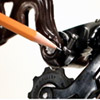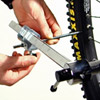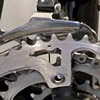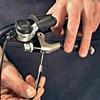How to Adjust Your Rear Derailleur
Applies to most 3-chainring derailleur systems. Adjust Front Derailleur
- How to Align a Rear Derailleur Hanger
- How To Install a Rear Derailleur
- How to Adjust Your Front Derailleur
Adjusting your rear derailleur can be frustrating. I’m hoping that this tutorial will help you understand how each component of your derailleur works, and how to set up and adjust it properly. Once your derailleur is set up correctly, most future adjustments can be done by hand. Let’s get started!
Required Tools
You’ll need a rag, a phillips screwdriver, a 5mm allen wrench, and a light lubricant like Triflow or Phil Wood Tenacious oil.
Rear Derailleur Components

How They Work
Almost all modern derailleurs function the same basic way. They are designed to move (or derail) the chain from one sprocket to the next. The upper guide pulley (or jockey pulley) moves the chain in both directions. For instance, when you want to climb a hill, you shift down to a lower gear. This pulls the shift cable and forces the guide pulley to change to a bigger sprocket. When you want to go faster, you adjust the shifter to a higher gear. This releases shift cable tension and allows the derailleur springs to pull the guide pulley back down to a smaller gear. Each time you shift gears, the length of chain changes. The lower tension pulley is spring-loaded to take up this slack.
Limit Screws
There are 3 adjustment screws – the B-Screw (B-tension adjustment), the H-Screw (high gear limit stop) and the L-Screw (low gear limit stop). Adjustments on these screws should always be made in 1/4 turn increments.
B-Tension Adjustment
The B-Screw controls the derailleur body’s angle in relation to the sprocket-set. Shift down to the largest sprocket and check the distance between the guide pulley and the large sprocket. If the guide pulley is rubbing on the sprocket, tighten the B-screw clockwise to increase tension and move the pulley away from the sprocket. If there is a large gap between the pulley and sprocket, loosen the B-screw until the pulley rubs the sprocket, and then tighten it until it just clears.
High Gear Limit Stop
The H-Limit screw high gear limit stop prevents the guide pulley from shifting any further past the highest gear and into the axle. In order to adjust it properly there must be no tension on the lower inner cable. If you feel tension, loosen the cable adjuster until there is none. Now check from behind how the chain is riding on the smallest sprocket. If it looks like it wants ride off into the axle, tighten the H-screw clockwise until it lines up. If it looks like it is rubbing on the next gear, loosen the screw until the chain is nicely centered on the sprocket. Now re-adjust the cable tension until the derailleur shifts smoothly down to the next gear.
Low Gear Limit Stop
The L-Limit screw prevents the guide pulley from shifting any further past the lowest gear and into the wheel spokes. Shift down to the lowest gear, step behind the bike, and check how the chain rides on the sprocket. If it looks like it wants to ride into the spokes, tighten the L-screw clockwise until it is centered on the sprocket. If it looks like it wants to shift down, loosen the screw until it lines up. As an extra precaution you can use your thumb to gently push the derailleur body and make sure the chain will not run into the spokes, as this could obviously have a nasty effect on both you and your bike.
Cable Adjustment
The cable tension adjuster defines how far up or down the derailleur moves. Step back so you can see the chain and sprocket alignment, and then through the gears in both directions, first shifting up two and down one, and then down two and up one. The chain should look centered on each sprocket. If it is rubbing on a larger gear it means there is too much tension on the cable. Loosen the tension by turning the adjuster clockwise. If it wants to jump down to a smaller gear it needs more tension. Increase the tension by turning the adjuster counter-clockwise.
You can also use sound to check the adjustment. There is always a base-level of noise that can be heard in every gear. This noise will increase in a slightly different way depending on which way the tension is out of adjustment. If there is too much tension you will hear a metallic rubbing sound, but if there is too little tension you will hear a clicking noise as the chain tries to jump to a smaller sprocket. There is usually a cable tension adjuster on your shift lever. With practice you will be able to make small cable tension adjustments while you are riding.
Lubrication
Now that the derailleur is adjusted, always apply a drop of lubrication to the derailleur’s many moving parts. This will help prevent wear from dirt and rust, and it will keep your gears shifting smoothly. Wipe away any excess lube and take your bike for a test ride to make sure all the gears are working smoothly.
That concludes our tutorial on rear derailleur adjustments… have fun!
Related Links
- Jim Langley: Rear Derailleur Adjustment
- Park Tool: Rear Derailler Adjustments
- Sheldon Brown: Derailer Adjustment
- Bicycle Torque Specifications
Recommended Tools
- Park Tool HXS-1.2 Hex Wrench Set
- Park Tool Wrench Combo Set
- Tri-Flow Superior Lube
- Park Tool SA-3 Heavy Duty Shop Apron
- Park Tool SK-3 Starter Mechanic Tool Kit
- Park Tool PK-3 Professional Tool Kit
Categories
Discuss this topic in the Bicycle Repairs and Mechanics Forum
Specialized expedition in need of repair
Latest post 16 hours agoHello I have recently pulled my 2005 specialized expedition out of the garage. It's in need of some repair due to it being damaged by super storm sandy. My shed was flooded with ocean water. The frame itself looks perfect but the moving parts have some rust. Including the fork, brakes, and gears. I'm just looking for replacement parts I have no intentions on buying a new bike. Please help than...
Read moreRear hub issue
Latest post 5 days agoI have a 10-year-old 105 rear hub, and one of the pawls is acting up, I cleaned it and relubed the hub pawls but it still won't engage as fast as it did, like one of the pawls isn't working. I think it might be time to get a new hub. I would like one that engages faster but don't want to spend the money for something like the DT Swiss hub, what recommendations do any of you have for a hub? Or i...
Read moreTyres keep popping off wheels...
Latest post 1 week agoHello guys Just bought a new pair of 700c hybrid wheelset with an inside rim width of 19mm. I have tried to fit schwalbe 700 x 40c tyres on them but the tyres just pop out from the rim when inflated. It seems to be a loose fit. Somebody please advise. Thanks...
Read moreWhat tools have you bought recently?
Latest post 2 weeks agoI'm slowly eliminated all LBSes in my area as options for servicing, LOL. The latest one has been struck off my list after watching, pained, their approach to removing the axle end caps from a hub with cartridge bearings. Suffice to say, I finally ordered a blind bearing puller kit and a bearing press kit. If you want something done properly, you have to do it yourself! Have you bought any nic...
Read moreModern rims crack at spoke holes
Latest post 2 weeks agoRecently, I was in one of the local bike shops. Someone had brought a bike back to have the back wheel re-trued. There were actually cracks in the rim, originating from the spoke holes. I have had the same problem with my bike. In past decades you could buy a bike, and the wheels were strong. With modern rims, the aluminum is getting thinner and thinner. Now the rims crack. With heavy riders, a...
Read moreAre all folding tyres made of Kevlar bead?
Latest post 3 weeks agoHello guys I understand cheaper regular tyres are made with a steel wire bead. But are all folding tyres made of Kevlar bead? I have just purchased a set of tyres as per attached photo and wanted to know if the bead is Kevlar. Can anybody please help? Thanks...
Read moreTire bead won’t seat into rim
Latest post 3 weeks agoI bought a Tamobyke V20. Both the front and rear tire beads slide off the rim when inflating much at all. How do I get them to sit in there where they belong? Pics attached ty!!! IMG_3164.jpeg (Size: 61.62 KB / Downloads: 42) IMG_3173.jpeg (Size: 46.46 KB / Downloads: 41) ...
Read moreHeadset overtightening
Latest post 3 weeks agoI have a Fondriest and could not get the headset to tighten without over tightening and then it will not steer properly because of heavy drag on the bars. I replaced the headset with no change so I replaced the steel fork with s Hylix carbon fiber bar and another new heatset and pinch steering head lock. Still it wont adjust properly. it acts as if the bottom headset bearing is too deep in the cup...
Read moreThread busted on right pedal crank
Latest post 3 weeks agoHi Ive joined to specifically ask about a problem which may have been covered before Im sure. My right pedal broke so I had to replace it. Then had issues getting the new pedal to go on straight so I was riding with it slightly at a bend. But then it just came loose and fell off. Problem is now the thread seems busted and the pedal just slots in with no screwing needed because the hole is enlar...
Read moreCup & Cone — Simple & Durable or PITA & Outmoded?
Latest post 4 weeks agoCup and cone hubs have long been considered simple, durable, easily maintained, and reliable. Having messed around with a couple of older hubs tonight, I ended up looking at my sealed-bearing hubs with increased fondness. I'm wondering what other people think. Should we old farts just accept that modern hubs with cartridge bearings are the way forward?...
Read moreTrek domane tyre
Latest post 1 month agoHi I have a trek domane 2.3, and I have changed the rear tyre to 28 (it was 25 originally) The tyre rubs with the brake arm (v brake), I fear it doesn’t seem to be compatible Is there any way to adjust the position of the brake arm? I just need it to ne around 2mm higher Thanks...
Read moreFalling back
Latest post 1 month agoIn December of 2009 I had a first generation carbon fiber fork break on my road bike and it dropped me right on my forehead. This gave me a very serious concussion and both ER doctors and most neurologists do not take them serious. So it took about two years of my slowly dying since I couldn't even remember to eat before my Cop friend took me to a proper neurologist who diagnosed it as a concussio...
Read moreDerailluer Hanger Alignment Tool
Latest post 1 month agoI cannot express enough about the importance of this tool when having to deal with multi speed bicycles. I have been in the bicycle biz in one fashion or the other for over 30 years. Have sold many new bicycles and 90% have been out of wack fresh from the box. With used bikes crossing your path you should just expect it to be bad. And never string new cables without checking the hanger first, ever...
Read moreChain sits on top of chainring when shifting up
Latest post 1 month agoHey guys, First post here. I've tried searching, but I don't know what you call this. I have a vintage Schwinn Passage that I picked up a few months ago. At first it worked well, but recently it's been giving me trouble. When I shift, the chain pops into the higher (larger) gear, but then sits on top of the chain ring. What ends up happening is that the chainring will keep turning, and eve...
Read moreWTB Raddler TCS 40c, small cut - repairable?
Latest post 1 month agoWent to fix the slow leak on my gravel bike's rear tyre. Found the culprit: a small cut near the middle of the tyre. The good news is it gave me an excuse to order a pair of Panaracer 43c semi-slick GravelKings (most of my local rides are more road-focused) to try out. Meanwhile, I was considering ye olde vulcanised patch repair to the inside of the tyre and superglue to the outside, but I'm thi...
Read more





